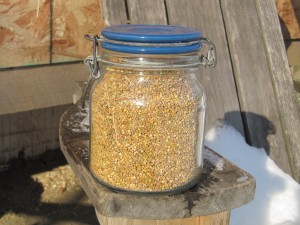Quinoa becomes an unlikely Alaska crop
March 25, 2013

Nancy Tarnai
907-474-5042
3/25/13
While Matt Springer was in Bolivia in 2006 he learned the ins and outs of producing quinoa, a pseudo grain that is actually seeds of the goosefoot plant. In South America it is known as the “mother grain of the Incas.”
Now he is successfully growing it in Fairbanks. “Quinoa is super great,” Springer said. “I’ve been interested in it for a long time.” In early trials at his farm up Rosie Creek Springer met with a few failures. “It was not so much the quinoa as myself,” he said. “A lot of what I do now is correct mistakes.”
Springer said his interest in growing food goes back to his early days, but for no apparent reason. He just had the desire to grow things. “It was just there,” he said.
He counts himself lucky to have two acres of family land for his farm, where he experiments with native, subsistence, diverse and reliable crops as well as medicinal plants. “I have very little space so I have to make tough choices,” he said. “The space fills up quick.”
In his search to get quinoa on the table he harvested a lot of the closely related weed, lamb’s quarters. “We eat more lamb’s quarters than any other greens,” Springer said. “It’s a super ubiquitous species. It is very mutable, flexible and diverse.” It can be eaten as steamed greens or served fresh in a salad. Springer has even made flour from the seeds. “It has a nutty, buckwheat quality.”
Taking what he learned in South America, Springer knew he could grow quinoa if he found the right strains. He became more determined as the demand for the grain surged. He has done his homework and cites the fact that quinoa was first grown in Alaska in 1906 at the agricultural research station in Copper Center. “It was considered a total failure,” Springer said.
Because quinoa is coated with saponin, a bitter layer that deters pests, it has to be carefully washed. “I learned firsthand in Bolivia to put it in a bowl, agitate it and change the water, to dry it and store in jars.”
Springer has studied permaculture in Scotland, Oregon and New York and began graduate studies at UAF last year. Last summer was his second season to successfully grow quinoa. “It was just finding the right seed,” he said. He hopes to continue his research and by next spring offer seeds to other area growers.
His interest is so intense that he met with one of the largest commercial North American producers of quinoa in Denver to spend an afternoon picking his brain. The takeaway was that seeds from Chile might be suitable for Alaska. Springer is letting some varieties cross and inbreed and outbreed. “I am hopeful the process of future selection works,” Springer said. “The seeds are best adapted to the longer season in the hills; I would like to think after a while it could be grown in the lower lands.”
He admits he babied the quinoa more than other plants, watering them in the beginning and keeping the plot very well weeded.
Local farmers have expressed interest in growing quinoa. “Others are experimenting,” Springer said. “Maybe in the future we will grow more of it.” Not only does quinoa have a rich, delicate, nutty taste, but it is high in protein has nearly the ideal balance for amino acids.
“It yields significantly better than other grains and many consider it nutritionally superior,” Springer said.
On a large scale the saponin coating presents problems, but not on the small scale that Springer bases his farm on. “It may not be practical on the commercial scale, but like it was for the families I stayed with in Bolivia, it is a subsistence crop.”
Springer enjoys eating quinoa as porridge with honey or milk or with vegetables and meat. “It’s really versatile; it can be in bread or a cold salad. There are lots of recipes.”
He looks forward to the day he can offer quinoa seed that is reliable throughout the Tanana Valley and hopes to travel to the southern ranges of Chile to learn about marginal or feral varieties, the ones missed in earlier selections because they were not large or robust.
“I like to cultivate my imagination and follow with research,” he said. “Plant history is storied and diverse, especially in a place like Alaska with relatively limited agriculture and horticulture history. If at first you don’t succeed, look for new varieties.”
Springer estimates his food consumption includes about 75 percent that he grows or harvests himself. “I think I could get to 100 percent except for the convenience of some storebought items. Every year we do more than before.”
This column is provided as a service by the UAF School of Natural Resources and Agricultural Sciences and the Agricultural and Forestry Experiment Station. Nancy Tarnai is the school and station’s public information officer. She can be reached at ntarnai@alaska.edu.


